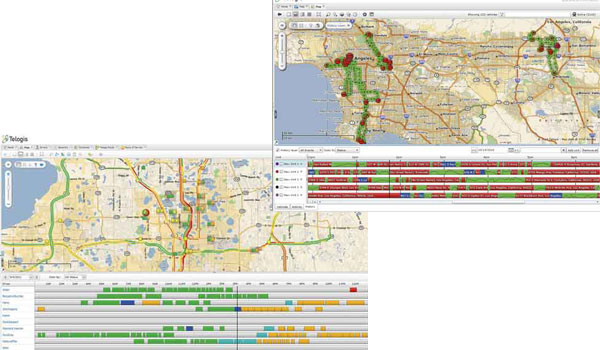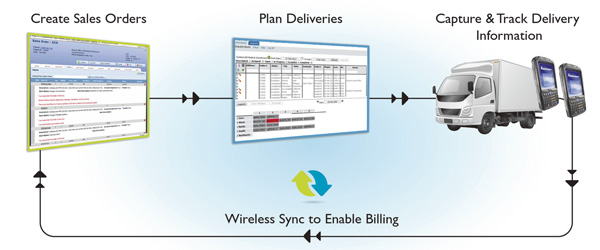Global positioning systems (GPS) are everywhere today, from our vehicles to our smart phones. In the business environment, especially related to fleet management, GPS technology provides a valuable tool to boost efficiency and increase employee accountability. Better delivery processes, greater overall awareness and lower fuel costs are some of the benefits. Others include enforcement of no-idling policies and more precise tracking of vehicle maintenance such as tire rotation and oil changes. When you add route optimization software to the mix, the benefits are compounded, including the ability to change routes dynamically to accommodate last-minute customer requests.
These technologies are mature and widely implemented in a variety of industries, but experts say their capabilities are not being fully utilized among HME/DME providers, which is ironic considering how desperate providers are to increase efficiency and lower costs in today’s competitive bidding climate.

Want to Save $400 a Month?
VGM Group offers the FleetTraks GPS system by On-Board Communications, and providers using the device report excellent results. VGM Fleet Management markets the solution to provide VGM members and other providers with real-time driving information about the locations and speeds of their fleet from any Internet-connected computer. The service archives the information for 12 months and is available to be downloaded to customer relationship management (CRM) programs for audits and compliance.
VGM members have confirmed the system’s ability to save costs. “We hear weekly from our members that after the units have been installed they see overtime decrease, gasoline costs go down and routes handled in a much more efficient manner,” says Merideth McDonald, vice president of VGM. “Members have reported a reduction in overtime of more than $400 per month per employee, along with an increase of 19 additional patient visits per month. That also impacts the quality of their customer service.”
The system enables providers to increase efficiency, for example by adding more stops in a day. It makes drivers accountable and improves their accounting. Because the system is hardwired to the vehicle, it can track mileage-based vehicle maintenance issues such as tire rotations or oil change frequencies. The system cost is about $1 per day per vehicle, regardless of fleet size, according to VGM.
Another advantage of the VGM On-Board system is idle time reductions. Excess idling time is an environmental concern due to increased air pollution, and every hour a vehicle idles consumes an extra gallon of gasoline. The On-Board system shows fleet managers the idle time per unit, which is valuable information to support discussions with drivers. “It is very hard to argue with facts when they are in black and white,” McDonald says. “The reduction in gasoline and wear and tear on vehicles is documented in the cost savings. In today’s environment, that adds up to a lot of money for the owner of a business.” Data from the On-Board system can also be exported into an ASCII file for use in other reports or systems.
In addition to the FleetTraks device that is hardwired to the vehicle, there is now a product (just released) that plugs into the vehicle’s on-board diagnostics (OBD) input.
Employees who use their own vehicles for business—such as salespeople, marketers and staff clinicians—don’t have to do mileage reports, as the mileage is compiled automatically by the On-Board system. A smart phone can turn the unit on or off so that it is only counting business-related miles. A battery backup ensures that no data is lost. The information can be extracted by personnel in the office and then mileage reimbursement is credited to the employee. Business owners can be confident they are reimbursing mileage in accordance with IRS guidelines. Giving employees the ability to export their automatic trip report saves them time and can impact payroll expenses by decreasing overtime.
The system also has route optimization capabilities but does not provide real-time directions for drivers, who would need to rely on a consumer system such as Garmin or Tom Tom for that capability.

Controlling Costs with Technology
InteliSky also supplies GPS and fleet management systems. The InteliSky GPS system enables HME providers to create operational effectiveness, lower costs and increase accountability and visibility among delivery drivers and other team members. The feature- and function-rich system offers a simple and intuitive interface and allows the use of advanced features with ease. “Given the current state of the industry and the economy, suppliers have a need to control costs without having to make a large capital spend or long-term commitment,” says Raj Tank, general manager of InteliSky. The system is offered with no device or installation costs and no contract.
In addition to the normal features of GPS systems, InteliSky also provides fuel level reporting, seat belt alarm, a Doppler weather overlay, maintenance tracking, route optimization with current traffic conditions and other capabilities.
The system roadmap allows HME providers to improve their daily operations. Over the next six months the system will add an integrated inventory tracking system, point of sale integration and fuel card integration.
Another supplier, Telogis, provides several products related to fleet management, route optimization and work order management. The company’s Fleet 9 software gives fleet managers and business owners greater flexibility to configure reports specific to their industry, and expands functionality and scalability to monitor asset utilization, theft and misuse. Telogis’ Route 3.0 is a Web-based multi-vehicle route optimization application providing greater routing efficiency and flexibility. Telogis’ Progression is a work order management platform that offers real-time job creation, tracking (estimating time of delivery), routing (including dynamic changes throughout the day), dispatching and real-time traffic conditions. The new Telogis Mobile handheld application connects workers in the field to the office with two-way messaging, hours of service reporting, dynamic job management and route optimization.
“First and foremost, it helps manage costs,” Sunil Mathew, director of sales engineering at Telogis, explains. “The margin is getting smaller and our applications help manage and reduce costs, either by cutting out behaviors that are costing money or by putting in procedures to understand where extra costs are coming from. Managing resources adds to efficiency, as does knowing more about how employees perform throughout the day.”
Telogis can also help promote driver safety. The system tracks driver behavior such as braking hard, which might suggest the driver isn’t watching the road and might be more likely to have an accident. The system also tracks fast starts, which can potentially increase wear and tear on engines, and speeding. These benefits are available with the Telogis Fleet product, which is often the entry point for smaller customers. Telogis can also help to track maintenance of vehicles based on mileage.
Telogis takes steps to ensure easy integration with other systems, such as providing an API (application programming interface). “We’ve never had a problem integrating with other systems,” Mathew says. The company can help with simple integration or bring in a third party.
Telogis serves a cross-section of markets, from oil and gas fleets to beverage delivery to food service. Some have embraced the technology more than others, according to Mathew. “Typically we can reduce from 8 to 10 percent in costs, based on miles driven, and can get a similar percentage gain in productivity based on our routing product.”

Integration with Business Systems
Integration of routing and GPS functionality with HME business systems can maximize efficiency and lower costs says Spencer Kay, president of Fastrack Healthcare Systems, supplier of software and technology to HME providers. Clients of Fastrack’s Routing and Delivery Automation module can send optimized routes to a Tom Tom GPS device in each delivery vehicle. The device provides turn-by-turn directions and presents the driver with the most efficient route for the day’s orders. Fastrack Routing analyzes the orders for the day and the available vehicles and uses routing algorithms to determine which orders should go on each truck and the most optimized route for the trucks. The system provides estimated arrival times for each stop.
The system is a fully integrated process. When orders are entered into the Fastrack software, the system goes to a routing module that considers resources, such as number of vehicles and delivery criteria, to schedule a delivery. The routing module enables maximum use of each truck and minimizes overtime. Benefits include less wear and tear on trucks, lower fuel costs and less overtime. “Within the system, we can see where each driver is at any time,” Kay says. “In case of an emergency, you can identify how close a driver is to a customer’s home.”
The system integrates a product designed by well-known consumer GPS supplier Tom Tom for fleet management. The Tom Tom Web Fleet product line allows dynamic routing capability that incorporates GPS. The capability can be used in conjunction with Fastrack’s enterprise software solution for HME providers.
Customer service personnel can have greater awareness of when a product will be delivered and how long a driver stays at each stop. “We can give the patient a fairly good understanding of when the driver will arrive,” Kay says.
The system also promotes accountability. Managers can see if a truck has been sitting two hours at one location, for example, or when the driver has veered off the route and may be using the truck for a personal errand.
“We have been offering these systems for a long time. The positive thing we are seeing is that more and more providers are adopting this technology to lower operational costs and become more competitive. Providers were hesitant for a while to make the investment, but this is an example of how technology can make a major difference in their operations.”
With GPS systems more common than ever in the consumer market, more people understand the benefits. “Before it was abstract, now it is very practical,” he says. “You have a more efficient route wherever you are going, and it’s a lot easier to explain the benefits.”
Fastrack Delivery and Routing also allows credit card payments to be processed in the field. The system scans bar codes to confirm the right product is being delivered, captures serial and/or lot numbers and collects the patient’s signature to acknowledge receipt of products. The information is sent automatically via a data/cellular connection back to the server.
“My advice is to have the routing system truly integrated with the business management system to get the greatest benefit,” Kay says.
Less Paperwork, More Efficiency
Eliminating paperwork is another benefit of route optimization systems, and Brightree’s Mobile Delivery electronically captures data from the field such as patient signatures and lot/serial numbers to confirm receipt of delivery orders and help ensure reimbursement. “Users can eliminate paper-based workflows and reduce manual steps by automatically loading orders onto drivers’ handheld devices, electronically capturing patient signatures, scanning product serial and lot numbers and capturing other key information to track inventory and provide proof of delivery,” according to Peter Herbert, Brightree’s vice president of marketing.
Part of the Brightree core billing and business management platform, Brightree Mobile Delivery wirelessly connects field personnel with mobile devices to enhance the delivery process. The solution tracks driver location via GPS to manage efficiency and define areas of operation. It also enables providers to accurately prepare and assign deliveries, track and confirm deliveries, and monitor drive locations and routes, all with an electronic workflow from office to field.
Brightree Mobile Delivery also helps to improve efficiencies. “Customers report that revenue and stops for deliveries, pickups and service have doubled,” Herbert explains. The system shares data among order generation, inventory and all aspects of delivery, then digitally forwards information to the central billing center.
Online Resources
Brightree
www.brightree.com
Fastrack Healthcare Systems
www.onlyfastrack.com
InteliSky
www.intelisky.com
Telogis
www.telogis.com
The VGM Group
www.vgm.com
